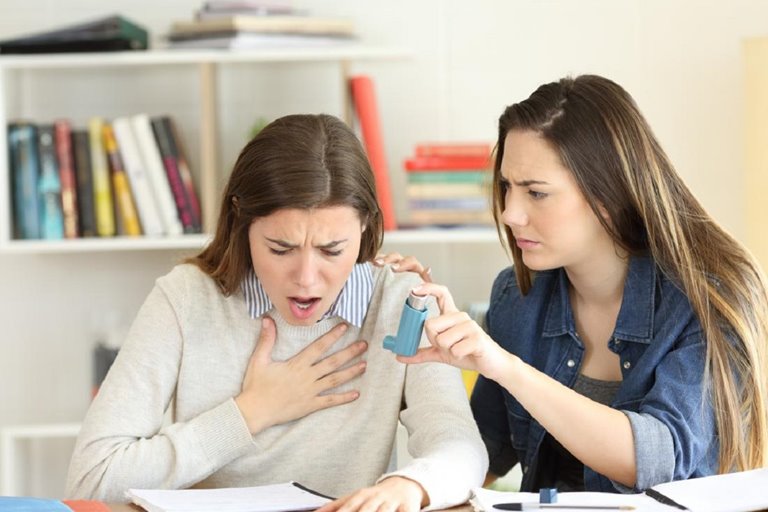Why does shortness of breath occur? What are the treatment and prevention methods?
Shortness of breath is not a disease. It is a symptom of conditions such as lung and heart disorders and coronavirus. The treatment for this problem varies depending on the cause.
Shortness of breath and shortness of breath make the patient feel uncomfortable and difficult. This problem can be caused by various factors such as coronary heart disease, lung diseases such as asthma, heart disease, and even anxiety.

The shortness of breath varies from mild and temporary to severe and long-lasting and is sometimes difficult to diagnose and treat. Because there are various reasons for it, in the following, we will acquaint you with the symptoms, causes, methods of diagnosis, treatment, complications, and prevention of shortness of breath.
Shortness of breath due to exercise
Shortness of breath can be caused by overexertion and spending time in a high place or even a sign of a wide range of problems. Symptoms of shortness of breath include:
Shortness of breath after exercise or due to illness
Feeling suffocated due to respiratory problems
Difficult breathing
Feeling of pressure in the chest
Fast breathing
heartbeat
cough
If shortness of breath occurs suddenly or the symptoms are severe, it may be a sign of a severe illness.
Causes of shortness of breath
Shortness of breath does not always happen for a reason. For example, a person may experience shortness of breath after strenuous exercise or going to altitude or significant temperature changes. However, shortness of breath is usually related to health problems. This condition can sometimes be just a fitness condition, and exercise can improve symptoms. But it can also be caused by a severe health problem.
According to experts, the most common causes of shortness of breath are asthma, heart failure, chronic obstructive pulmonary disease, interstitial lung disease, pneumonia, and mental health problems, often associated with anxiety. Note that if shortness of breath starts suddenly, it is called “acute shortness of breath.”

In general, acute shortness of breath can occur for the following reasons:
- Asthma
- Anxiety
- Suffocation or inhalation of something that blocks the airways
- Allergic reactions
- Anemia
- Blood loss resulting from anemia
- Prolonged exposure to carbon monoxide
- Heart failure
- low blood pressure
- Pulmonary embolism or the presence of a blood clot in a pulmonary artery
- Lung problem
If a person has shortness of breath for more than a month, this condition is called “chronic shortness of breath.” Chronic shortness of breath can occur for the following reasons:
- Asthma
- Chronic obstructive pulmonary disease
- Heart problems
- Obesity
- Injury and damage to the lungs
- Lung cancer
- Tuberculosis
- Pulmonary hypertension

Risk factors for shortness of breath
Environmental pollutants such as chemicals, steam, dust, and smoke can make it difficult for people with shortness of breath to breathe. Exposure to allergens such as dust or mildew can cause shortness of breath in people with asthma. Of course, some pollutants can be prevented, such as smoking.
Chronic obstructive pulmonary disease and chronic bronchitis are other factors that make it difficult for people to breathe. According to COPD, not all people with shortness of breath necessarily have chronic obstructive pulmonary disease. But 90% of people with the disease were smokers at some point in their lives.
Complications of shortness of breath
Shortness of breath can be associated with hypoxemia, which refers to a lack of oxygen in the blood. This, in turn, can lead to decreased levels of consciousness and other severe symptoms in people.
If shortness of breath persists and persists, there is a risk of temporary or permanent cognitive impairment, signing that other medical problems start or worsen.
When should I see a doctor?
Shortness of breath can sometimes be life-threatening. Therefore, if you experience any of the following symptoms, you should see a doctor immediately:
- Sudden onset of severe shortness of breath
- Inability to perform activities due to shortness of breath
- Pain and feeling of pressure in the chest
- nausea
Not all types of shortness of breath require immediate medical attention. But shortness of breath can have serious health problems. We recommend that you consult your doctor if you experience any of the following symptoms:
Changes in the type of breathing and feeling of weakness
Limit daily activities due to respiratory problems
Difficulty breathing during sleep
Inflammation in the feet and ankles
Fever, chills, and cough
Note that spirometry can be an effective way to measure airflow and lung capacity because it can determine the exact type and extent of people’s respiratory problems. Other tests can also check the oxygen level in the patient’s blood and the blood’s capacity to carry oxygen.
Methods of treating shortness of breath:
Treatment for shortness of breath depends on the cause. A person who suffers from shortness of breath due to excessive pressure is likely to recover and stabilize after resting and achieving calm. But in some severe cases, oxygen is needed.
People with chronic illnesses, such as obstructive pulmonary disease, need medical advice and care to improve breathing. This treatment program helps prevent acute events and slow the progression of the disease.
If shortness of breath is associated with asthma, medications such as bronchodilators and steroids may be beneficial. If the shortness of breath is due to an infection such as bacterial pneumonia, antibiotics can be beneficial. Of course, other medications, such as nonsteroidal anti-inflammatory drugs (NSAIDs) and anti-anxiety drugs, can also be helpful.
Respiratory problems caused by the chronic obstructive pulmonary disease can be improved with special breathing techniques such as lip curve breathing and muscle-strengthening breathing exercises. People can learn the exact way to do these things in pulmonary rehabilitation programs. Many people have made significant progress by doing these things and getting positive results.
If tests show low levels of oxygen in the blood, supplemental oxygen may be needed. However, not all people with shortness of breath have low oxygen levels in their blood. Experiments have shown that the symptoms of many people with shortness of breath improve with a gentle flow of cool air around their head and face.

Quit smoking
Avoid other irritants such as chemical vapors and contaminants.
Weight Loss; Because it can reduce restlessness of the heart and lungs and make exercise more comfortable. It is not harmful to know that these factors can strengthen a person’s cardiovascular and respiratory systems.
Try to avoid activities at heights because it can make breathing difficult.
Shortness of breath in certain groups
Shortness of breath can affect a specific group of people in different ways.
In the following, we will refer to these groups:
Pregnancy
Mild symptoms of shortness of breath are common during pregnancy and occur because pregnancy alters a woman’s ability to breathe. Of course, it is good to know that although the respiratory capacity increases during pregnancy, the lung volume decreases by 20% at the end of pregnancy.
The elderly and those with serious health problems
Shortness of breath can be a novel that people are in advanced stages of chronic diseases. At this stage, the doctor prescribes some medications to help patients recover. But keep in mind that taking some medicines to treat shortness of breath can cause more patient problems.
infants
Upper respiratory tract diseases that cause acute shortness of breath in infants are severe and require immediate hospitalization. Remember that these diseases are one of the most important causes of shortness of breath in infants.
Result
Shortness of breath can occur in people for various reasons, and its treatment depends on its exact cause. If the shortness of breath is due to an underlying condition such as pneumonia or mild asthma, treatment of these conditions may reduce or significantly reduce respiratory problems.
If shortness of breath is caused by a severe or chronic illness, such as chronic heart failure or severe asthma, or chronic obstructive pulmonary disease, which gets worse over time, it may not improve ultimately. Patients with shortness of breath should be monitored and consulted regularly to develop and follow a comprehensive treatment plan.
also read :
The best home remedies for eczema


